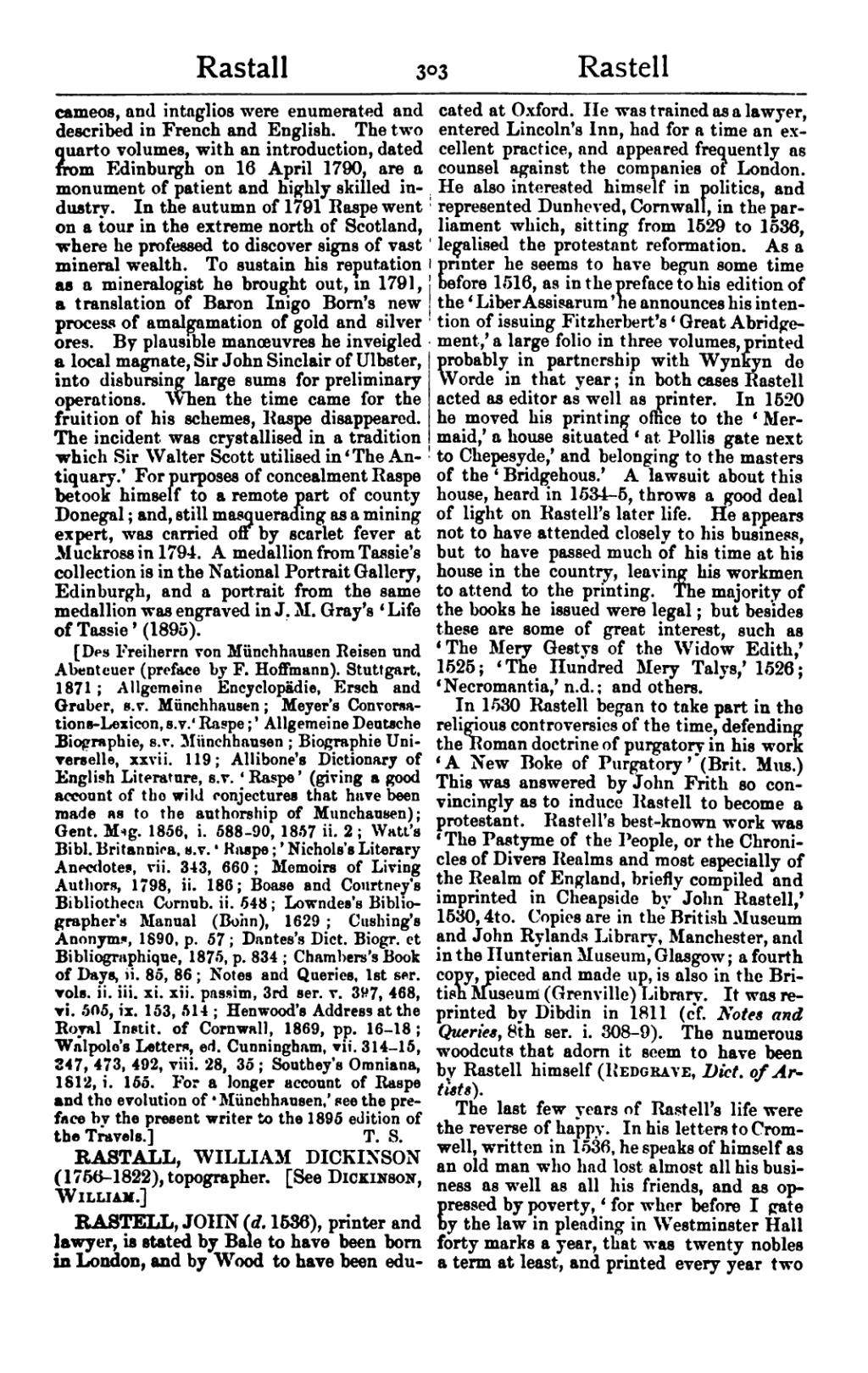cameos, and intaglios were enumerated and described in French and English. The two quarto volumes, with an introduction, dated from Edinburgh on 16 April 1790, are a monument of patient and highly skilled industry. In the autumn of 1791 Raspe went on a tour in the extreme north of Scotland, where he professed to discover signs of vast mineral wealth. To sustain his reputation as a mineralogist he brought out, in 1791, a translation of Baron Inigo Born's new process of amalgamation of gold and silver ores. By plausible manœuvres he inveigled a local magnate, Sir John Sinclair of Ulbster, into disbursing large sums for preliminary operations. When the time came for the fruition of his schemes, Raspe disappeared. The incident was crystallised in a tradition which Sir Walter Scott utilised in ‘The Antiquary.’ For purposes of concealment Raspe betook himself to a remote part of county Donegal; and, still masquerading as a mining expert, was carried off by scarlet fever at Muckross in 1794. A medallion from Tassie's collection is in the National Portrait Gallery, Edinburgh, and a portrait from the same medallion was engraved in J. M. Gray's ‘Life of Tassie’ (1895).
[Des Freiherrn von Münchhausen Reisen und Abenteuer (preface by F. Hoffmann), Stuttgart, 1871; Allgemeine Encyclopädie, Ersch and Gruber, s.v. Münchhausen; Meyer's Conversations-Lexicon, s.v. ‘Raspe;’ Allgemeine Deutsche Biographie, s.v. Münchhausen; Biographie Universelle, xxvii. 119; Allibone's Dictionary of English Literature, s.v. ‘Raspe’ (giving a good account of the wild conjectures that have been made as to the authorship of Munchausen); Gent. Mag. 1856, i. 588–90, 1857 ii. 2; Watt's Bibl. Britannica, s.v. ‘Raspe;’ Nichols's Literary Anecdotes, vii. 343, 660; Memoirs of Living Authors, 1798, ii. 186; Boase and Courtney's Bibliotheca Cornub. ii. 548; Lowndes's Bibliographer's Manual (Bohn), 1629; Cushing's Anonyms, 1890, p. 57; Dantes's Dict. Biogr. et Bibliographique, 1875, p. 834; Chambers's Book of Days, ii. 85, 86; Notes and Queries, 1st ser. vols. ii. iii. xi. xii. passim, 3rd ser. v. 397, 468, vi. 505, ix. 153, 514; Henwood's Address at the Royal Instit. of Cornwall, 1869, pp. 16–18; Walpole's Letters, ed. Cunningham, vii. 314–15, 347, 473, 492, viii. 28, 35; Southey's Omniana, 1812, i. 155. For a longer account of Raspe and the evolution of ‘Münchhausen,’ see the preface by the present writer to the 1895 edition of the Travels.]
RASTALL, WILLIAM DICKINSON (1756–1822), topographer. [See Dickinson, William.]
RASTELL, JOHN (d. 1536), printer and lawyer, is stated by Bale to have been born in London, and by Wood to have been educated at Oxford. He was trained as a lawyer, entered Lincoln's Inn, had for a time an excellent practice, and appeared frequently as counsel against the companies of London. He also interested himself in politics, and represented Dunheved, Cornwall, in the parliament which, sitting from 1529 to 1536, legalised the protestant reformation. As a printer he seems to have begun some time before 1516, as in the preface to his edition of the ‘Liber Assisarum’ he announces his intention of issuing Fitzherbert's ‘Great Abridgement,’ a large folio in three volumes, printed probably in partnership with Wynkyn de Worde in that year; in both cases Rastell acted as editor as well as printer. In 1520 he moved his printing office to the ‘Mermaid,’ a house situated ‘at Pollis gate next to Chepesyde,’ and belonging to the masters of the ‘Bridgehous.’ A lawsuit about this house, heard in 1534–5, throws a good deal of light on Rastell's later life. He appears not to have attended closely to his business, but to have passed much of his time at his house in the country, leaving his workmen to attend to the printing. The majority of the books he issued were legal; but besides these are some of great interest, such as ‘The Mery Gestys of the Widow Edith,’ 1525; ‘The Hundred Mery Talys,’ 1526; ‘Necromantia,’ n.d.; and others.
In 1530 Rastell began to take part in the religious controversies of the time, defending the Roman doctrine of purgatory in his work ‘A New Boke of Purgatory’ (Brit. Mus.). This was answered by John Frith so convincingly as to induce Rastell to become a protestant. Rastell's best-known work was ‘The Pastyme of the People, or the Chronicles of Divers Realms and most especially of the Realm of England, briefly compiled and imprinted in Cheapside by John Rastell,’ 1530, 4to. Copies are in the British Museum and John Rylands Library, Manchester, and in the Hunterian Museum, Glasgow; a fourth copy, pieced and made up, is also in the British Museum (Grenville) Library. It was reprinted by Dibdin in 1811 (cf. Notes and Queries, 8th ser. i. 308–9). The numerous woodcuts that adorn it seem to have been by Rastell himself (Redgrave, Dict. of Artists).
The last few years of Rastell's life were the reverse of happy. In his letters to Cromwell, written in 1536, he speaks of himself as an old man who had lost almost all his business as well as all his friends, and as oppressed by poverty, ‘for wher before I gate by the law in pleading in Westminster Hall forty marks a year, that was twenty nobles a term at least, and printed every year two
